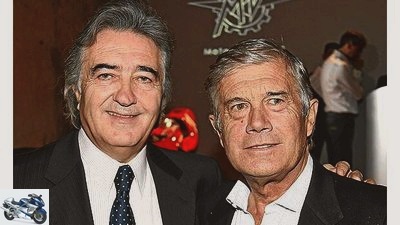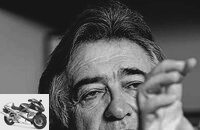Table of contents

Gori
Sports & scene
Claudio Castiglioni – on August 17th the boss of MV Agusta died
On the death of Claudio Castiglioni
On August 17th, the boss of MV Agusta died
Claudio Castiglioni, boss of MV Agusta, died on August 17th. With his ideas and visions he shaped the motorcycle industry like no other for decades.
Eva Breutel
09/01/2011

archive
The eternal dream: Castiglioni, who died of cancer at the age of 64, would have loved to return to racing with his friend Giacomo Agostini. There he celebrated triumphs with Cagiva in the 1990s.
Claudio Castiglioni did not make his best appearances in the spotlight of the trade fairs when he praised the company’s latest model with genuine Italian pathos as the most beautiful and best motorcycle of all time. And not on the racetracks either, where he worked with the brands Cagiva and Ducati Celebrated triumphs. Rather, he was most convincing and at the same time most lovable when he discussed passionately with his employees at the plant – and they expressed their opinion as vehemently as he did, without fear of the big boss. “Signor Claudio” was what his workers and employees called him confidentially and trustingly. In Italy, which is hierarchical and addicted to titles, where even the bosses of five-man companies address themselves as “Signor Presidente” and allow themselves to be courted accordingly, a remarkable exception.
Castiglioni never needed courtiers; he sought open discussion. Even with journalists, if he discovered the true spark of motorcycle passion in them, he let go of all business-like restraint, went over to you at the latest at the second interview appointment and instigated intensive discussions about motorcycles. They talked their heads together, often late into the night, and Castiglioni shared his ideas for future models and engines with his counterpart. Thanks to a unique instinct, he already knew instinctively what motorcyclists would like the day after tomorrow.
Cagiva, Ducati, Husqvarna, MV Agusta: all these companies owe their existence or their rebirth to him. In 1978 he and his older brother Gianfranco founded their first motorcycle brand in Varese, 50 kilometers north of Milan. It carried on the name of the father’s company for small metal parts: Cagiva, an abbreviation for CAstiglioni GIovanni VArese. Initially, the brothers only built small-displacement motorcycles, but in 1983 they signed an agreement with Ducati for the supply of medium and large-volume engines. Rescue in dire need for the manufacturer from Bologna, because at the time it was under the supervision of state administrators who wanted to concentrate on the construction of diesel engines for the automotive industry. It was only thanks to the agreement with Cagiva that the motorcycle division stayed alive. In 1985 the Castiglionis took over the helm and turned the company inside out. While brother Gianfranco gradually withdrew from the motorcycle business, Claudio called in technicians from Varese and well-known consultants to help, rebuilt the development department and made Ducati shine in new splendor.
Buy complete article

On the death of Claudio Castiglioni
On August 17th, the boss of MV Agusta died
4 pages) as PDF
€ 2.00
Buy now
In addition, he began a collaboration that lasted over 20 years and turned out to be extremely fruitful: He bought the small development center of Bimota founder Massimo Tamburini in San Marino and secured his support. Together, the two two-wheelers created real milestones in motorcycle history over the next few decades, most notably the Ducati 916 in 1994, which redefined the term “super sports car” and is still considered to be one of the most beautiful motorcycles in the world. It shares this title with the one presented in 1997 MV Agusta F4, also a joint effort by Tamburini and Castiglioni, just like the Naked Bike Brutale. In 1990 the two created the Cagiva Mito, which revolutionized the 125cc market with its 32 hp two-stroke engine, 175 km / h top speed and the look of a Grand Prix racer. Also on Castiglioni’s initiative, the Ducati Monster was created in 1993, the first representative of modern naked bikes, this time in collaboration with the designer Miguel Galluzzi.
These fascinating motorcycles only became a reality because Castiglioni largely gave his employees a free hand. Without calculating costs, they were allowed to develop to their heart’s content, order parts and often even produce them. “From an entrepreneurial point of view, I’m more of a nut,” he admitted a few years ago in an interview with MOTORRAD. “I just can’t get excited about numbers.”
That took revenge. At the height of his work, in the early 1990s, he owned Cagiva, Ducati, MV Agusta, Husqvarna and Moto Morini, a true Italian motorcycle pool that could have served all branches. But Castiglioni’s business was never a clever business strategy; his companies kept falling into the red. Which was due not only to his underdeveloped sense of numbers, but also to a truly immeasurable generosity. To name just one example: In the excitement of Italy’s victory at the World Cup in Germany, he created the special model MV Agusta Brutale 910 R Italia in 2006 – and honored all of the players and coaches in the national team. It was expensive fun, especially since it didn’t even exploit the action in terms of PR.
In addition, his enthusiasm for racing kept pulling him into investments that he could not really afford. With Husqvarna he cleared in the Motocross World Championship; in Castiglioni’s aegis, which lasted from 1987 to 2007, the brand won a whopping 55 of its 78 world championship titles. With the Cagiva Elefant he was involved in the Paris-Dakar rally, where Edi Orioli won twice in 1990 and 1994. But his real passion was road racing. He had been competing in the Grand Prix with Cagiva since 1982, and when Eddie Lawson finally clinched his first victory in the 500cc four-cylinder in Hungary in 1992, Castiglioni let his tears of joy run free in the pit lane. The fact that John Kocinski even competed for the title in 1994 and the small brand Cagiva stood up to the giants from Japan was an enormous satisfaction for him. He achieved even more with Ducati. As the driving force behind the founding of the Superbike World Championship, he laid the foundation for the sporting success of the red racers from Bologna, which continues to this day.
But all of these racing activities cost a lot – too much. And so he had to gradually smash his own empire again. He sold Ducati to the US fund TPG in the mid-1990s, which hit him hard: According to his own statement, he never set foot in the Bolognese plant again. He also gave up the Moto Morini brand, for which he had tourer and custom plans that were never realized. Husqvarna became the property of BMW in 2007.
When the inevitable sale of Ducati began to emerge, Castiglioni concentrated fully on another Italian premium brand: MV Agusta, acquired in 1992, rumored to have won after a game of poker against Count Rocky Agusta – an anecdote that he left with a wink. And he actually managed to breathe new life into Italy’s most famous brand. But it did not go off without turbulence here either: Castiglioni sold the brand twice, once to Proton, once to Harley-Davidson, and twice he bought it back for little money. It was painful for him until the end that he did not succeed in making MV at home on the world’s racetracks again. His long-time friend Giacomo Agostini, who had already acted as team boss at Cagiva, was on call for this adventure.
That never happened, but Cas-ti-g-lioni leaves his son Giovanni an impressive legacy, including the three-cylinder MV Agusta F3, which caused a sensation at the Milan trade fair last year. In addition to family and friends, an entire industry is now mourning one of its key figures. Castiglioni is not only a brilliant motorcycle developer, but also an entrepreneur who actually felt responsible for his employees. “He always gave us the feeling of being part of his projects,” said the moving statement by the MV employees, which was read out during the funeral. “And he has never forgotten that the most important thing for a company is its workers, managers and employees. Addio, Signor Claudio.
Related articles
-
Portrait of Claudio Castiglioni
archive Sports & scene Portrait of Claudio Castiglioni Claudio Castiglioni The impresario and the Italian motorcycle history Content of For more than…
-
Massimo Tamburini died on April 5, 2014
MOTORCYCLE archive 6th pictures MOTORCYCLE 5/2004 1/6 Portrait of Massimo Tamburini from MOTORRAD 5/2004 (by Eva Breutel). MOTORCYCLE 5/2004 2/6 Portrait…
-
MV Agusta F4 Claudio special model
MV Agusta 34 pictures MV Agusta 1/34 MV Agusta has launched a new special model. MV Agusta 2/34 The special model is called Claudio and pays homage to…
-
Fausto Gresini died: MotoGP team boss loses corona fight
Gresini Racing Sports & scene Motorsport Fausto Gresini died: MotoGP team boss loses corona fight Fausto Gresini died MotoGP team boss loses corona fight…
-
counselor technology & future Report: Cagiva Motor Report: Cagiva Motor The Emperor strikes back With a new engine, new models and a new structure,…
-
motorcycles Roll-out MV Agusta F4-750 Roll-out MV Agusta F4-750 Ago’s comeback Around a quarter of a century after his last World Championship title on…
-
Soldano motorcycles MV Agusta Brutale 1078RR MV Agusta Brutale 1078RR Full intoxication Content of Uwe Seitz 08/20/2008 Full intoxication MV Agusta…
-
Ducati boss Domenicali announces electric motorcycle
Rendering: Bart Heijt, Fernando Pastre counselor traffic & business Ducati boss Domenicali announces electric motorcycle Ducati boss on the subject of…
-
MV Agusta motorcycles News: Europe and USA News: Europe and USA Harley-Davidson and MV Agusta For the 105th company anniversary, the successful series of…
-
NSU / Audi 11 pictures simplicissimus.info 1/11 The history of the motorcycle began around 1900. BMW 2/11 In the deepest valley of the motorcycle…